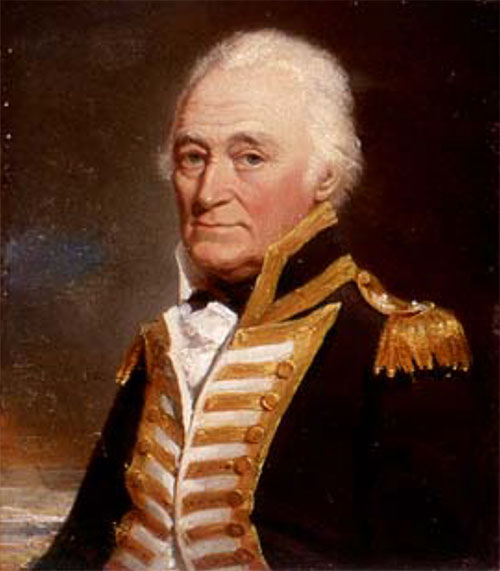In December 1792, Captain John Hunter was appointed second Governor of New South Wales, 11 September 1795 – 27 September 1800.
Governor Hunter began his appointment in difficult circumstances. Three years passed without a governor, after Phillip left in 1792. The New South Wales Corps took control of the colony under the command of Major Francis Grose. Many of the policies created by Governor Phillip to enable fair governance, were abandoned. The Corps controlled all trade, allocation of convict labour, and allocated free land grants to each other – increasing their personal wealth tenfold. Lieutenant John Macarthur was one of the Corps’s
influential members who had been given extensive land grants. This made him very wealthy and a powerful enemy for Hunter to control.
The Corps took over law and order by removing civil magistrates, replacing them with their own officers. Removing this separation of powers gave them full control. The trade in rum became a powerful currency amongst the soldiers. Its influence was extensive and corruption quickly took hold. People in positions of power could not be trusted and operated outside the law.
The British Government failed to understand how bad things really were as all information relayed between England and the governor was controlled by the Corps. Important details were frequently altered, omitted, delayed, or withheld making it almost impossible for Hunter to effectively manage the colony’s needs. Any direction from England was also delayed for up to a year, with events rapidly changing dramatically. The Corps did not want the government to know about its new-found privileges and how it extensively
controlled everything in the colony.
When Hunter returned as the governor, he had no idea how much things had changed since he left the colony in 1791. Back then, the colony was a penal settlement making the governor’s authority final, as chief jailer. The governor controlled food supplies, convict labour allocation, the military, and land grants. But now, the rules had changed. Governor Hunter could not properly impose his orders, because the Corps effectively controlled the colony.
Hunter was recalled to England in a stern dispatch after the Corps submitted claims of incompetence and mismanagement to the government. He immediately requested a public inquiry, but was ignored. It wasn’t until Hunter published a book on his experiences that the government took note, and his reputation was restored.
The average life expectancy in mid-18th century England was around 37 years for men and women. However, John Hunter lived for 83 years. He passed away on 13 March 1821, at Hackney, London.
John Hunter’s original drawings can be found in the Nan Kivell Collection, at the National Library of Australia.
See the other resources on the First Five Governors
– Arthur Phillip
– John Hunter
– Philip Gidley King
– William Bligh
– Lachlan Macquarie
John Hunter was a Royal Navy Officer of the British Fleet. As First Lord of the Admiralty 1783, he reached the rank of Vice-Admiral
John Hunter was Captain of HMS Sirius of the First Fleet in 1788
The New South Wales Corps was formed in 1789 to replace the Marine detachment that had arrived on the First Fleet
Hunter sat in Australia’s first court of Criminal Judicature 11 February, then officially appointed Justice of the Peace by Governor Phillip 12 February 1788
Captain Hunter shipwrecked the Sirius on approach to Norfolk Island in March 1790, whilst attempting to deliver much needed supplies to the fledgling colony
Hunter had an intertest in natural sciences and sent samples of Australian flora and fauna back to England for study. He was an excellent writer and made precise observations of Sydney’s topography and daily events. His work had provided some of the most important documents of early British occupation in Australia


